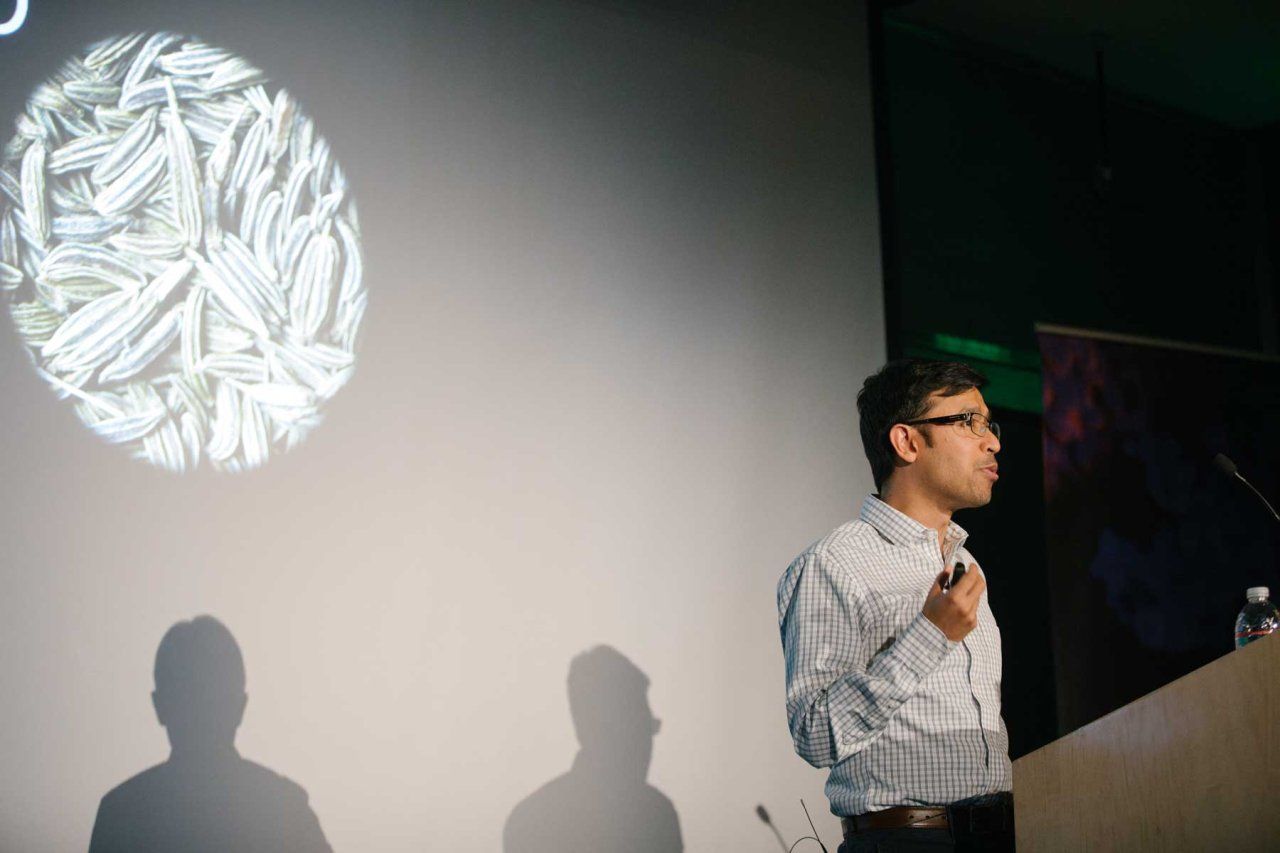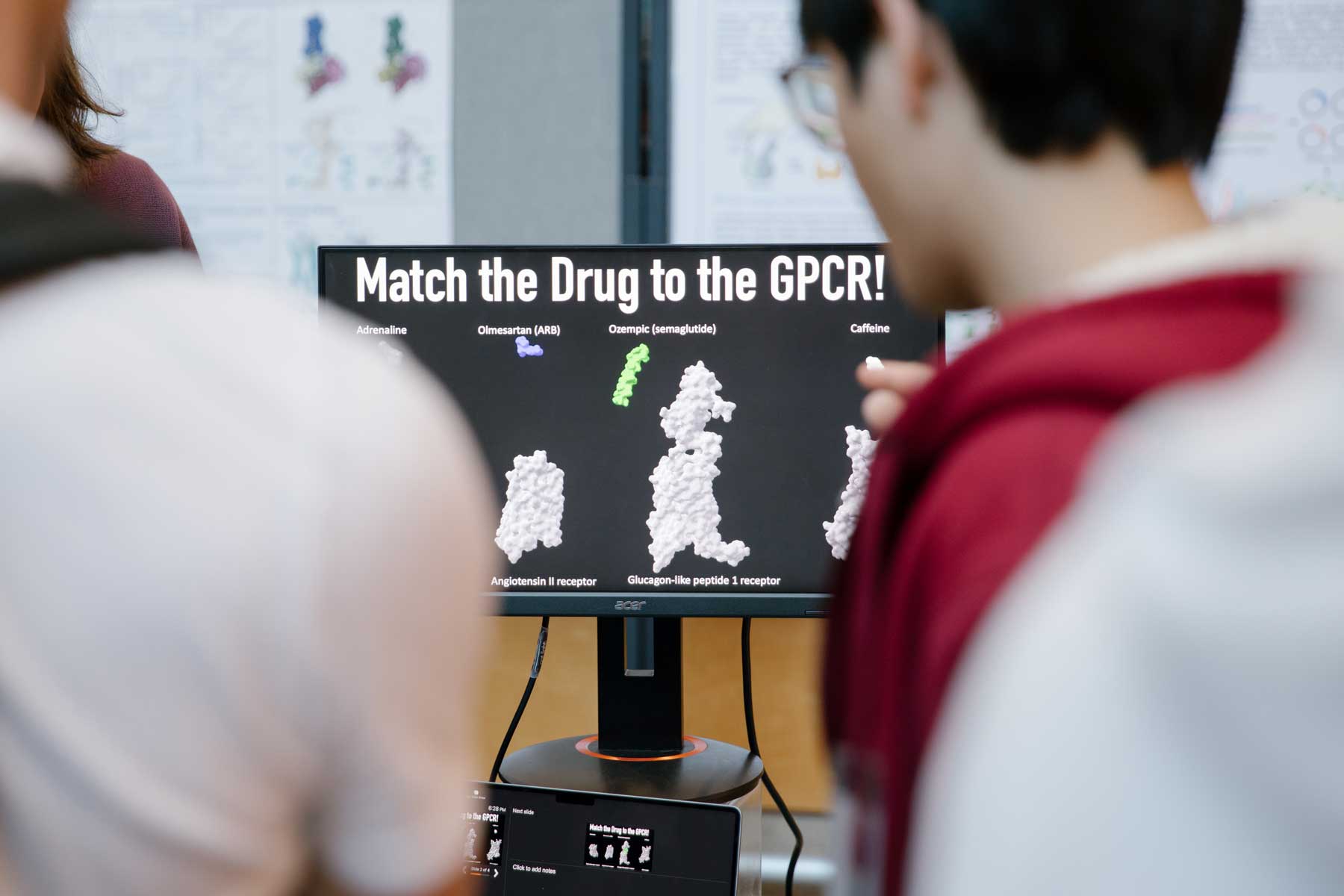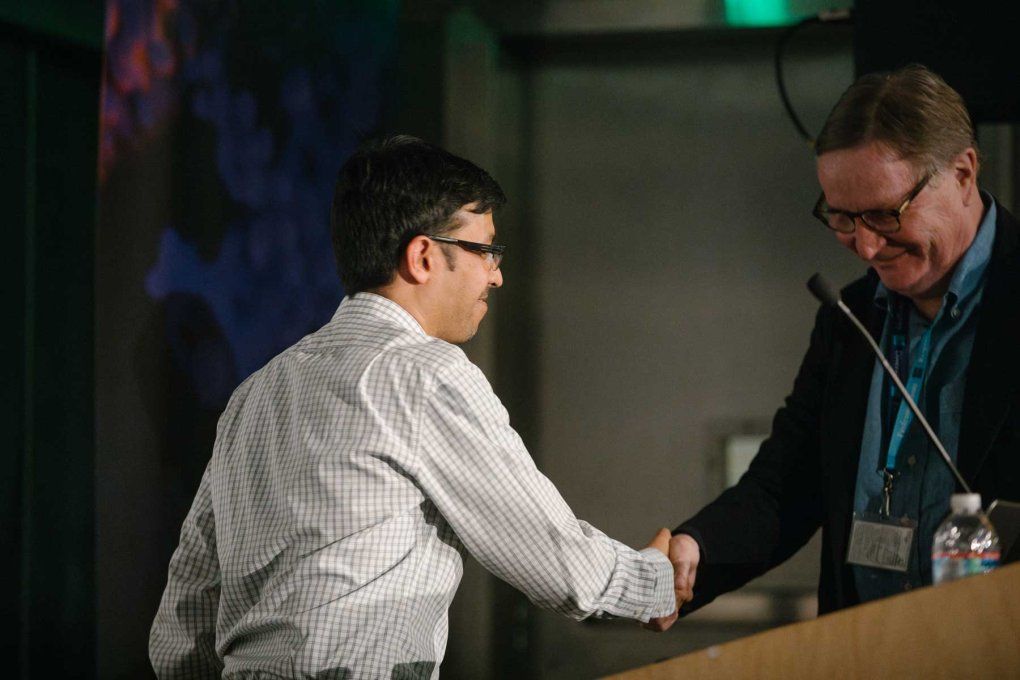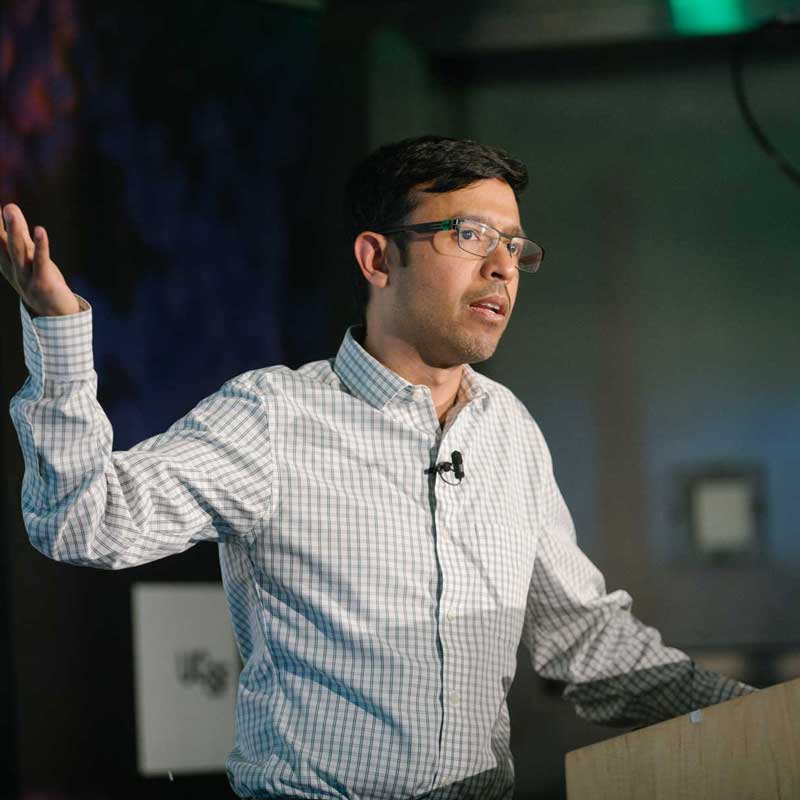Cracking Codes in Cellular Communication
How do cells inside our bodies receive messages from outside our bodies?

Aashish Manglik, MD, PhD, was a Stanford University graduate student in 2011 when he tackled one of modern medicine’s biggest challenges: opiate addiction and its often-lethal side effects.
Determined to grasp how morphine relieves pain, Manglik created 3D models to watch how the narcotic’s atoms interact with a G protein-coupled receptor (GPCR). These specialized protein receptors act as communication channels that allow our cells to respond to environmental messages from outside our bodies so we can see, taste, and smell.
Once he visualized the morphine-protein interaction, Manglik realized he could create a new molecule like morphine to ease pain without the fear of overdose and death. The discovery led to an encounter with venture capitalist Brook Byers, a longtime friend of UCSF, that Manglik says he will never forget.
The physician-scientist told his story before a crowd at Genentech Hall that gathered in April to hear him deliver the 29th annual Byers Award Lecture. Manglik, an associate professor in the Department of Pharmaceutical Chemistry with a joint appointment in the Department of Anesthesia and Perioperative Care, presented his lecture, “Signal Reception: Cracking Codes in Cellular Communication.”
Cellular communication is at the heart of how our neurons talk to one another when we think and how our heart knows to beat faster when we run.”
Aashish Manglik, MD, PhD
Science considered “high risk”
UCSF Chancellor Sam Hawgood, the Arthur and Toni Rembe Rock Distinguished Professor, introduced Manglik after paying tribute to Byers, a lifetime member of the UCSF Foundation Board of Directors, and his wife, Shawn, for founding the award that recognizes how basic science advances knowledge, drives innovation, and addresses global challenges.
Hosted by the Sandler Program for Breakthrough Biomedical Research (PBBR), the Byers Award supports outstanding research of junior faculty members whose innovative ideas the National Institutes of Health (NIH) deems too high risk for funding. Like the Byers Award, PBBR supports curiosity-driven science and has achieved remarkable success doing so. Hawgood said PBBR has generated 3,800 peer-reviewed scientific publications, 120 patents, and more than 450 NIH and National Science Foundation awards and has supported over 1,000 investigators. Remarkably, he noted, recipients of PBBR awards have generated discoveries that have resulted in $1.77 billion in funding for scientific research.
Manglik, the very definition of a curiosity-driven scientist, joined UCSF in 2017 from Stanford, where he found a field that allowed him to combine his interests in biology, medicine, and chemistry to find his passion: cellular communication. Understanding how GPCRs transmit and receive messages could reveal how drugs, including opiates, are able to kill pain, relieve depression, and even stop our noses from running. Understanding these receptors is key to developing new medicines and treatments, Manglik said, because the 800 GPCRs in the human genome are our bodies’ largest group of drug targets and represent one of science’s best chances of creating successful therapies.
“The fundamental problem that my lab is interested in is, how does information come from the outside world to the inside?” asked the first-generation Indian immigrant. “Cellular communication is at the heart of how our neurons talk to one another when we think and how our heart knows to beat faster when we run. Our dream is to make cellular communication programmable in the same way that our electronic devices have made communication programmable. If we could do this, we could come up with new ways of restoring health. This would transform our ability to control cellular communication for health and disease.”

UCSF’s ‘most audacious work’
Crediting support from the Byers family for empowering UCSF to do its “most audacious work,” Manglik proceeded to prove his point.
To envision how molecules transmit messages, he and his team created maps he calls “molecular cartography.” Equipped with high-powered microscopes that enable scientists to view the atoms in their own spatial environment, the Manglik Lab sought a new molecule that would behave like morphine but not suppress the impulse to breathe. While working in the Stanford lab of Brian Kobilka, MD, winner of the 2012 Nobel Prize in Chemistry, Manglik began collaborating with Brian Shoichet, PhD, a professor in UCSF’s Department of Pharmaceutical Chemistry, and discovered a new molecule called PZM21 that relieved pain in mice without causing death.
“In a true UCSF story, Brian Shoichet, who was then a collaborator and is now a mentor, introduced us to Doug Crawford at the California Institute for Quantitative Biosciences (QB3), who got us a meeting with Brook Byers,” Manglik said with a grin.
“I’ll never forget the interaction with Brook. We’re telling him about our work (finding PZM21), and he is diligently taking notes. I was halfway through discussing our data when Brook closed his pen and put it down. I thought, ‘Man, this is terrible. He hates this,’” Manglik said, pausing as the audience reacted.
“What’s amazing is, Brook looked up with complete conviction and said, ‘We have to do something about this.’ With his help, we set up a company called Epiodyne that has been tinkering with these molecules and is now on the cusp of taking a version of PZM21 for the full gauntlet of clinical trials starting this year.”
Achieves dream of joining UCSF – thanks to Byers
Manglik gave Byers credit – not only for Epiodyne but also for being among the chorus of voices convincing him to leave Stanford where he was a School of Medicine Distinguished Fellow – and join UCSF, where he had set his heart on doing research since his days as an undergrad.
“Big thanks to Brook for taking this long arc – probably the longest-running project in my lab – and moving it to a stage where it’s potentially useful for people,” Manglik said. “This convinced me that UCSF has a phenomenal community. And with the help of two great department chairs – (former chair) Matt Jacobson in Pharmaceutical Chemistry and Michael Gropper in Anesthesia and Perioperative Care – I finally fulfilled my dream of joining UCSF.”

At UCSF, Manglik and his team have continued their research into GPCRs, the proteins that are so critical for our bodies’ biological functions. He focused on how these proteins affect the thyroid in the autoimmune ailment known as Graves’ disease, in which patients develop antibodies that mimic the thyroid protein. This molecular mimicry disrupts the thyroid’s main job of controlling our metabolism, which is how our bodies use energy.
“The one thing I didn’t mention earlier is that the way that we treat Graves’ disease hasn’t changed for the past 60 years,” he said. “Understanding how antibodies and hormones turn this receptor on provides at least one avenue for developing new therapies to treat Graves' disease.”
In 2023, Manglik’s lab had a breakthrough in the sense of smell by showing for the first time how an odorant, or smell molecule, activates a particular olfactory receptor. Published in the prestigious journal Nature, the findings open the way to understanding olfactory receptors, which constitute half of the human body’s GPCRs.
“This is curiosity-driven research,” Manglik observed. “We don’t understand how our sense of smell works. But if we solve this fundamental problem, the approaches that will develop along the way will be broadly applicable for understanding how chemistry interfaces with biology.”
As Chancellor Hawgood noted in his introductory remarks, this is exactly what Byers envisioned when he founded the Byers Award Lecture: “Basic science serves as the very bedrock of scientific progress and is essential for improving our understanding of the world and enhancing the quality of human life.”

2024 Byers Award
The Byers Award recognizes outstanding research by a faculty member in the middle of their career.
Aashish Manglik’s honorary lecture is titled “Signal Reception: Cracking Codes in Cellular Communication.”